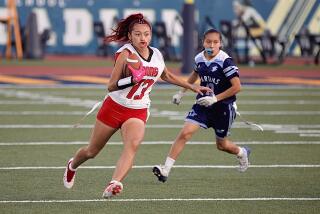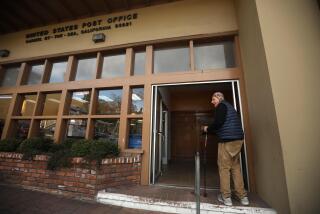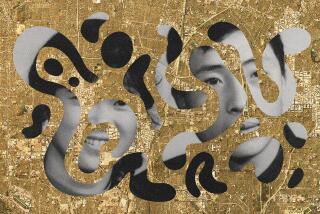Bill to Put Area Code Switches on Hold Has Support of Entrepreneurs
A bill that would impose a statewide moratorium on area code changes is hitting a nerve with angry small-business owners who want an end to code confusion.
The Encino, West Hollywood and Beverly Hills chambers of commerce have endorsed AB 818, introduced by Assemblyman Wally Knox (D-Los Angeles). The California Chamber of Commerce and the California Small Business Assn. are watching its progress. And small-business owners hurt by area code switches say it’s about time somebody did something.
The bill, which goes before the Assembly Utilities and Commerce Committee next week, would impose a moratorium on area code changes beginning Jan. 1. It also would require the California Public Utilities Commission to work out alternative solutions to satisfying the demand for new phone numbers before creating more area codes.
Southern California businesses already struggle with 13 area codes. Five more will be in use by May 2000, and three others are proposed. They involve splits--cutting areas in two and adding a new area code--and overlays--imposing a new area code for all new users in old areas.
“I’m all for a moratorium, because it’s been a colossal hassle having Costa Mesa split up the way it is,” said Jennifer Stockland, owner of Costa Mesa Florists, who last year had to change her area code from 714 to 949.
“We’re constantly having to ask people what the area code is and then we get the wrong one,” she added. “It divides the city. We’ve had to have everything reprinted, business cards, pamphlets, you name it.”
Area code changes can be a nightmare for businesses because the telephone number is a lifeline to customers, said Charles Carbone, a consumer advocate with the Utility Consumers’ Action Network, a San Diego-based consumer rights organization with about 8,000 small-business owners among its 40,000 members.
“If it’s not easy to get hold of you, and you’re in a highly competitive product or service, your customer is not going to wait,” Carbone said. “They’re going to go immediately to your competitor, whose number they have in front of them.”
Code Changes Can Damage Business
Business owners say that overlays, touted as the solution to area code splits, create their own problems, such as saddling a growing business with two area codes. Danny Ruiz, pharmacist at Statscript Pharmacy in West Hollywood, fears that adding a phone line with the 424 area code, when he already has 310, will confuse his elderly customers, who may stop turning to him for prescriptions and medical advice.
Laria Pippen, interim president of the West Hollywood Chamber of Commerce, says the city is only 1.9 square miles but will have three area codes--310, 323 and 424--when the new 424 overlay takes effect in July.
For companies that rely on local identity, the lack of a geography-specific area code can damage business, as Stockland, the Costa Mesa florist, well knows. Out-of-state customers seeking a local florist felt confident that they were getting a bona fide Costa Mesa florist when she had a 714 area code, Stockland said. But since the change to 949 last year, long-distance phone customers now question her location, thinking she’s moved outside the city.
“We hear personal, heartbreaking stories,” said Mary Jo Borak, a regulatory analyst with the PUC, who regularly holds public hearings on area codes. (The PUC has not taken a position on Knox’s bill.) Borak said one Oakland business owner, who repairs big-rig truck axles, told state officials his area code losses came to $50,000, because he relied on business cards handed out to truckers.
When Oakland switched from 415 to 650, he had no way to notify thousands of truckers across the nation about his outdated phone number. Although he spent $30,000 in additional advertising, his business still declined by $20,000 in one year, Borak said.
Knox insists that the technology exists to provide area code relief, but that industry and PUC inertia, plus a conflicting maze of federal and state regulations, block the solution and create number hoarding and area code chaos.
In California, for example, an estimated 180 million phone numbers are available under current area codes, but only 30 million are in use, according to PUC Commissioner Henry Duque. Yet the push for more area codes continues.
The reason is the inefficient way phone service computers and software keep track of phone numbers assigned to service carriers. The equipment keeps track, not of individual numbers, but of the prefix, the first three digits of each seven-digit phone number.
Each prefix has 10,000 available numbers. A new phone company, for example, gets 10,000 numbers at a time for each relatively small geographic area, even if it wants only 3,000 numbers.
Demand from small-business owners and others with one or two voice lines, a fax line, Internet connections, pagers, cell-phones and even car phones is not the problem. The allocation system is the problem.
Fixing that problem will require not only Knox’s bill in California, but also action at the federal level. The North American phone numbering system, if left as is, has a shelf life of only 20 years, according to federal estimates.
The Federal Communications Commission is considering a proposal to conserve numbers using existing technology. The proposals include assigning numbers individually or in smaller blocks of 1,000, called “number pooling,” to phone service carriers. Hearings may be held later this year, but any proposed solution would take three to four years to implement and involve substantial expense and reprogramming of equipment by major carriers.
Relief Efforts Appear Stalled
The telecommunications industry has begun looking at expanding the number of digits used in phone numbers by one or two numbers. Telephone system equipment here and abroad would have to be changed, as well as consumer phone equipment, phone-reliant equipment such as alarms and databases with phone numbers, in addition to the expense of informing others.
At the state level, progress on area code relief appears stalled because California’s phone carriers are not willing to undertake number pooling voluntarily. The PUC says it is blocked from ordering carriers to take such conservation measures because of a September FCC ruling in a Pennsylvania case, Borak said.
For its part, the FCC denies that it has blocked mandatory pooling, saying it encourages states to submit plans and citing the example of Illinois, where mandatory number pooling recently received FCC approval.
The dispute is symbolic of the misunderstandings and conflicts in authority that exist between state and federal communications officials, with each pointing a finger at the other for stalled progress and delays. It helps explain why phone users keep shouldering the burden of more area codes when demand actually is coming from telecommunication companies and not users.
Knox’s bill attempts to break through the logjam by requiring the PUC to seek FCC permission for number pooling, to set aside certain area codes for machines such as faxes and modems, and to reassign and recycle disconnected numbers faster.
“I don’t think for a moment I’ve worked out the answer or resolution, but it’s clear to me someone needs to play a role,” Knox said.
For online information about area codes, go to https://www.cpuc.ca.gov or https://www.pacbell.com.
Times staff writer Vicki Torres can be reached at (213) 237-6553 or at [email protected].
(BEGIN TEXT OF INFOBOX / INFOGRAPHIC)
Codes at a Glance
Southern California currently has 13 area codes from Santa Barbara to San Diego. Five new ones go into effect by May 2000, and three more await California Public Utilities Commission approval.
Codes are assigned in two ways: A geographic area is split in two, with one part keeping the old number and the other receiving the new, or the area is overlaid with two area codes, with a new number given to new phone customers.
Area code: 213
Date in service: Oct. 1947
Geographic area: Los Angeles
*
Area code: 714
Date in service: 1951
Geographic area: Orange County, San Diego
*
Area code: 805
Date in service: 1957
Geographic area: Ventura, Santa Barbara, Northern L.A. County (also San Luis Obispo, Bakersfield)
*
Area code: 619
Date in service: 1982
Geographic area: San Diego
*
Area code: 818
Date in service: 1984
Geographic area: San Fernando Valley, San Gabriel Valley
*
Area code: 310
Date in service: 1991
Geographic area: Western, eastern and southern L.A. County
*
Area code: 909
Date in service: 1992
Geographic area: Riverside, San Bernardino
*
Area code: 562
Date in service: Jan. 1997
Geographic area: Eastern L.A. County, Long Beach
*
Area code: 760
Date in service: March 1997
Geographic area: Portions of San Diego, Imperial, Riverside, San Bernardino, L.A. counties
*
Area code: 626
Date in service: June 1997
Geographic area: Portions of San Gabriel Valley
*
Area code: 949
Date in service: April 1998
Geographic area: Southern Orange County
*
Area code: 323
Date in service: June 1998
Geographic area: Los Angeles
*
Area code: 661
Date in service: Feb. 1999
Geographic area: Northern L.A. County (Lancaster, Palmdale) parts of Ventura and Santa Barbara counties
*
Area code: 858
Date in service: June 1999
Geographic area: North San Diego County, La Jolla
*
Area code: 424 (overlay)
Date in service: July 1999
Geographic area: Western L.A. County, Catalina Island
*
Area code: 935
Date in service: June 2000
Geographic area: East San Diego County
*
Area code: 909 (split)
Date in service: Feb. 2000
Geographic area: San Bernardino and Riverside counties to have separate codes; number to be assigned.
*
Area code: 714 (overlay)
Date in service: May 2000
Geographic area: N. Orange County; number to be assigned
*
Area code: 562
Date in service: July 2000
Geographic area: Eastern L.A. County, Long Beach; decision pending; hearings scheduled (see below)
*
Area code: 818
Date in service: August 2000
Geographic area: San Fernando Valley, San Gabriel Valley; decision pending.
*
Area code: 760
Date in service: Oct. 2000
Geographic area: Parts of San Diego, Imperial, Riverside, San Bernardino, L.A. counties; decision pending
*
Area code: 909 (overlay)
Date in service: Feb. 2001
Geographic area: San Bernardino County; number to be assigned
Public hearings on 562 split or overlay
* April 7, 1999, 1 p.m., Long Beach City Council Chambers, 333 West Ocean Blvd.
* April 7, 1999, 7 p.m., Downey Community Center, Diane Boggs Auditorium, 7810 Quill Drive
* April 8, 1999, 1 p.m., Whittier Community Center, Meeting Rooms 1 & 2, 7630 Washington Ave.
More to Read
Inside the business of entertainment
The Wide Shot brings you news, analysis and insights on everything from streaming wars to production — and what it all means for the future.
You may occasionally receive promotional content from the Los Angeles Times.










